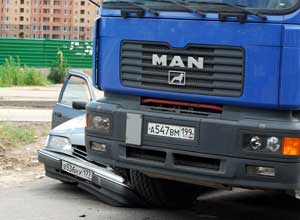Staying Safe on the Road
|
|
Modern methods of traveling have really changed the world. Trips that once took days now take hours; ones that took hours can now take minutes. We have progressed from traveling on foot, to riding on horses or donkeys or in wheeled vehicles pulled by these animals, to pedaling bicycles, and to driving or riding in motorized vehicles such as motorcycles, cars, buses, or trucks. Along with all these vehicles came roads for them to travel on.
|
The highways in Baku, Azerbaijan, can slow to a crawl at certain times of the day. All sorts of vehicles travel on these roads. |
Some ancient roads still exist, like this one in Ireland’s countryside. Unmodernized roads cannot accommodate modern traffic, however. |
Road safety has been a concern pretty much since the first roads were constructed in ancient Mesopotamia, in about 4000 BCE. These roads were meant to provide a more solid surface for wheeled vehicles, but they were actually traveled by everyone on the move: wheeled vehicles, people on foot, and, for most of human history, in many parts of the world, people riding horses and donkeys. Since the first roads, the number of wheeled vehicles has increased exponentially.
A variety of vehicles share modern-day roads, depending on where you live. In some countries you can see automobiles, buses, trucks, horse- or bullock-drawn carts, motorcycles, scooters, mopeds, bicycles, and rickshaws all using the same roads. And of course, there are people walking. All the vehicles move at different speeds, unless they are stuck in a traffic jam. Each driver sees the road and the surrounding vehicles from his or her own angle and perspective on the road. And most of the time each vehicle is heading for its own unique destination. The combination of these factors makes traveling on modern roads a challenge.
|
Motor bikes and motor bike-pulled carts must contend with trucks and cars on the roads of Phnom Penh, Cambodia. |
Buses, automobiles, and motorcycles, travel the famous cobblestones of the Champs Elysees in Paris, France. |
In the small town of Zipaquira and in many other places around Colombia, animal-pulled wagons travel alongside trucks and cars on the roads. |
As road travel became more complex, rules of the road developed, to control the location and direction of vehicles. Signals and signs control the flow of traffic. However, not everyone observes the rules or obeys the signals and signs. When people fail to cooperate in this manner, they place others as well as themselves at risk. In addition, many situations arise that are simply not covered by the rules. Many factors can make travel more difficult: poor road design, ill-maintained vehicles, and bad weather can create all sorts of hazards.
|
|
Photo courtesy of Mikhail Vorotyntsev Drivers of smaller vehicles need to be aware of the locations of larger trucks, as demonstrated by this road accident that occurred in Tyumen, Russia. |
The big danger: collisions between vehicles, with pedestrians, or with stationary objects along the road. An accident can cause serious injuries and even death to the drivers of the involved vehicles, their passengers, and even people in vehicles or along the road who are not directly involved. Property along roads may also suffer damages.
Better safety equipment for drivers, passengers, and vehicles counteracts this. Over the years, such things as headlights, braking lights, windshield wipers, and defrosters to clear fogged windows have made it easier for drivers to see what’s on the road around them. Better tires or special tires for weather conditions such as snow, antilock brakes, and all-wheel drive or traction control help drivers prevent accidents in bad weather. When an accident does occur, equipment such as seat belts, headrests, and airbags, as well as helmets for riders of motorcycles and bicycles, provides greater protection for the people involved.
|
Good road safety habits start early. Young drivers should learn the importance of using seatbelts when they learn to drive. |
Airbags, which inflate on impace, have been credited with saving many lives in head-on crashes. |
Side curtain airbags provide extra protection in sidelong accidents. |
|
|
Photo courtesy of Juan Esteban Revelo Hinestroza Pedestrians and sellers of flowers or other items may also share the roads with all kinds of vehicles. |
The behavior of drivers, passengers, and pedestrians—whether walking along the road, riding a bicycle or motorcycle, or riding in or driving a car—affects safety. The more experienced driver or rider is generally a safer driver or rider. The exception comes through careless behavior—for example, by using alcohol or other such substances that can impair one’s judgment before taking charge of a vehicle or even going for a walk along a busy road.
Individual governments and the international community are taking note of the dangers of the road. The United Nations and other organizations have launched various initiatives designed to raise awareness and address the problem of road safety on a global basis. In fact, the United Nations has designated the third Sunday in November each year as a World Day of Remembrance for Road Traffic Victims.
 |
Digging Deeper
Find out more about |
We all have a role to play here. It’s our lives that are at stake. So we’re going to look at how to stay safe for four main ways in which you may get around: the car, the motorcycle, the bicycle, and your own two feet. We’ll skip buses because in general there’s not much passengers on public transportation can do about safety. Don’t get on or off a moving bus, though—that’s asking for trouble.
The history of the automobile is a good way to start looking at road safety. As vehicles grew bigger, faster, and more powerful, better safety equipment was needed to protect drivers and passengers. But behavior by drivers, passengers, pedestrians, bicyclists, and motorcyclists all contribute to staying safe on the road.









.jpg?n=5504)


